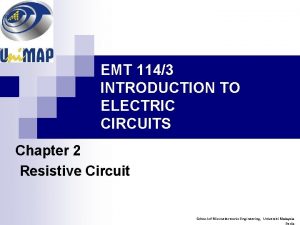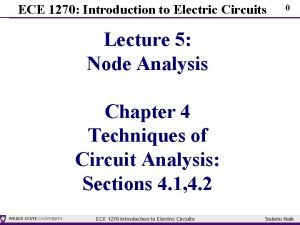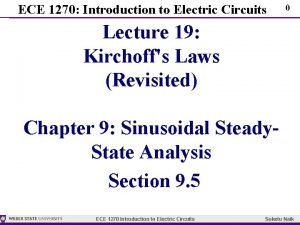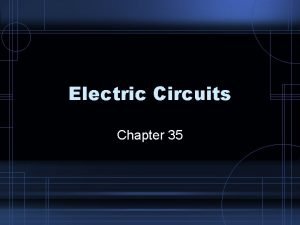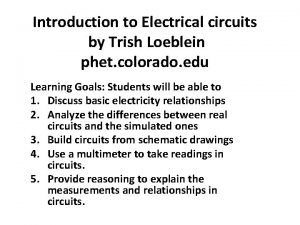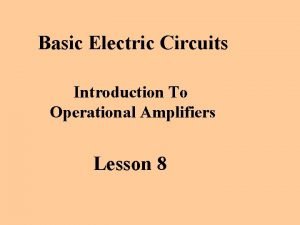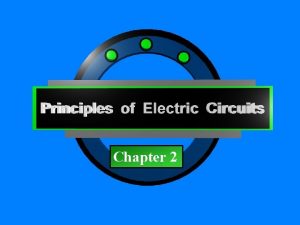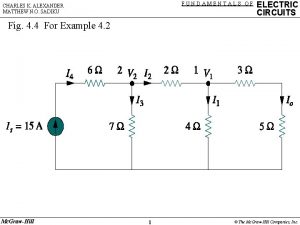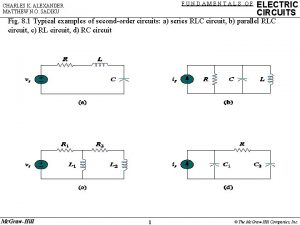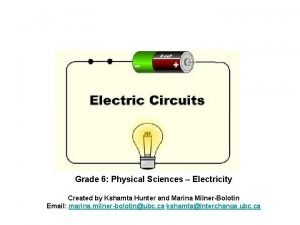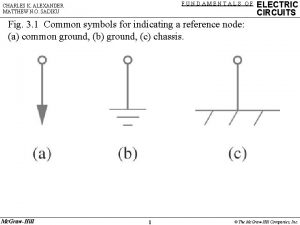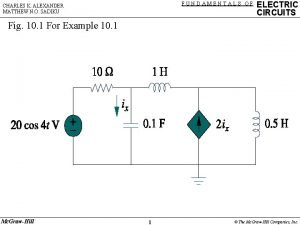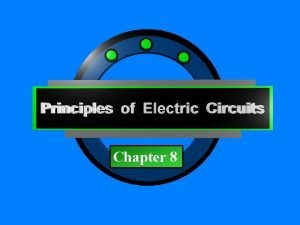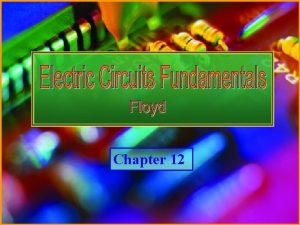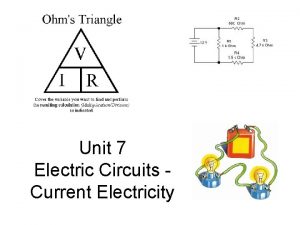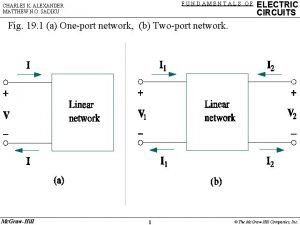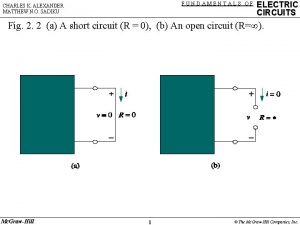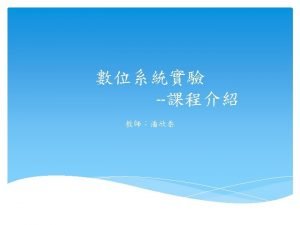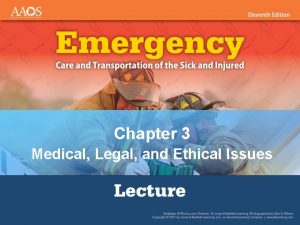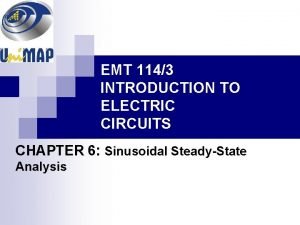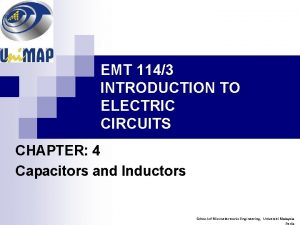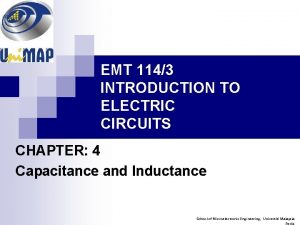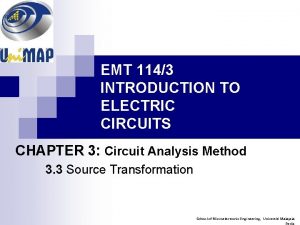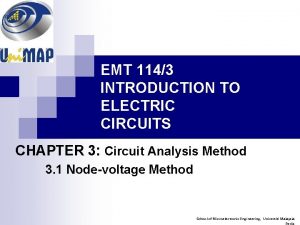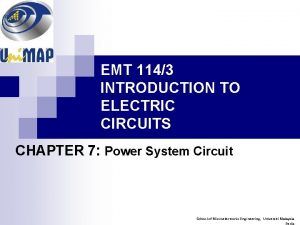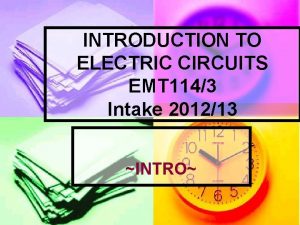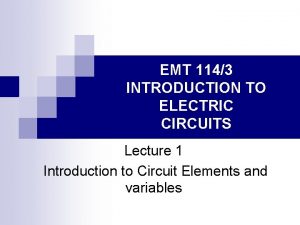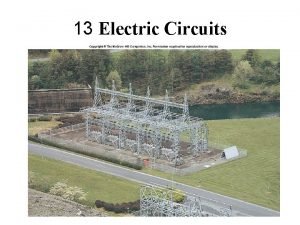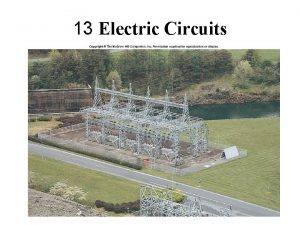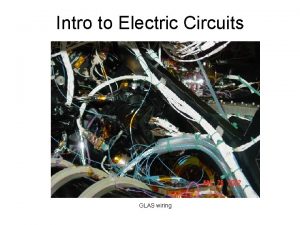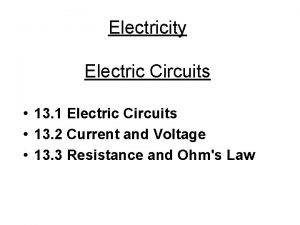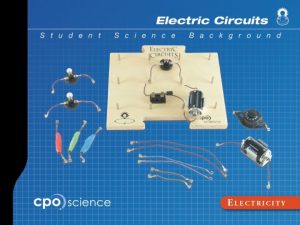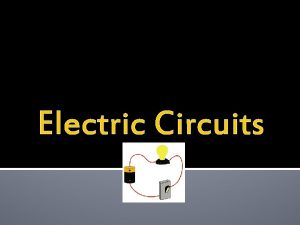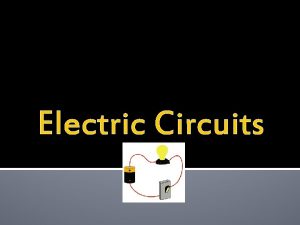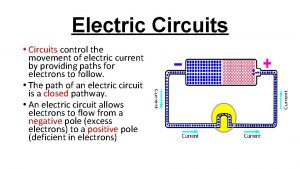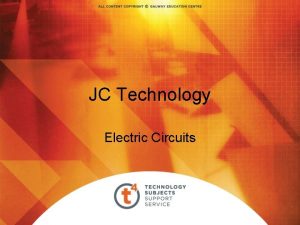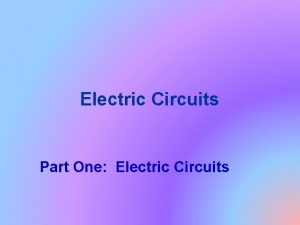EMT 1143 INTRODUCTION TO ELECTRIC CIRCUITS CHAPTER 5






































- Slides: 38

EMT 114/3 INTRODUCTION TO ELECTRIC CIRCUITS CHAPTER 5: First and Second Order Circuit 5. 1 First order Response of RC and RL Circuit

STUDY WEEK LAB 3 ETE RLC w 12 w 11 w 10 sinusoidal w 13 3 phase w 14 w 15 2 Port

OUTLINE Introduction First Order RC Circuits üNatural Response of RC Circuit üStep Response of an RC Circuit First Order RL Circuits üNatural Response of RL Circuit üStep Response of an RL Circuit

Introduction Ø A first order circuits is characterized by a first-order differential equation Ø Ø There are two types of first order circuits: ¨ Resistive capacitive, called RC ¨ Resistive inductive, called RL There also two ways to excite the circuits: ¨ Initial conditions ¨ Independent sources

1. Source Free RC Circuit Ø Ø Ø Natural Response (source-free) of a circuit refers to the behavior (in terms of voltages and currents) of the circuits itself, with no external sources of excitation. A source free RC circuit occurs when its dc source is suddenly disconnected. The energy stored in the capacitor is released to the resistors. Ø Since the capacitor was initially charged, we can assume at t=0 the initial voltages is: Ø Consider a series combination of a resistor and a initially charged capacitor as shown:

1. Source Free RC Circuit A circuit with voltage source

1. Source Free RC Circuit n For t = 0 ¨ Voltage ¨ Energy

1. Source Free RC Circuit Applying KCL to top of node First Order Differential Equation Rearrange it Integrates both sides Integration Constant

1. Source Free RC Circuit Thus for t>0, Current Energy

1. Source Free RC Circuit n Power ¨ For t>0

1. Source Free RC Circuit n The graph of the natural response of RC circuit

1. Source Free RC Circuit The time constant, τ determine how fast the voltage reach the steady state

1. Source Free RC Circuit The key to working with a source-free RC circuit is finding: where 1. 2. The initial voltage v(0) = V 0 across the capacitor. The time constant = RC.

1. Source Free RC Circuit -Example

1. Source Free RC Circuit Practice Problem 7. 1

2. Source Free RL Circuit A first-order RL circuit consists of a inductor L (or its equivalent) and a resistor (or its equivalent) By KVL Inductors law Ohms law

2. Source Free RL Circuit RL circuit with current source

2. Source Free RL Circuit For t = 0 Current Energy

2. Source Free RL Circuit Thus for t > 0 Current Energy Voltage

2. Source Free RL Circuit Thus for t > 0 Power

2. Source Free RL Circuit 1. Get the equivalent circuit

2. Source Free RL Circuit

2. Source Free RL Circuit Practice Problem 7. 4 Ø For the circuit in below, find i(t) for t > 0.

Comparison RL and RC Comparison between a RL and RC circuit A RL source-free circuit where A RC source-free circuit where

Summary of Source Free Circuit 1. The key to working with a source-free RC circuit is finding: a) The initial voltage v(0) = V 0 across the capacitor. b) The time constant = RC. 2. The key to working with a source-free RL circuit is finding: a) The initial voltage i(0) = I 0 across the capacitor. b) The time constant = L/R.

3. Step Response of RC Circuits Ø When the dc source of an RC circuit is suddenly applied, the voltage or current source can be modeled as a step function. Ø The Step Response of a circuit is, it’s behavior when the excitation is the step function, which may be a voltage or a current source.

Voltage for Step Response of RC Circuits Ø We assume an initial voltage of V 0 on the capacitor. Applying KCL: Ø For t>0 this becomes: Ø Integrating both sides and introducing initial conditions finally yields: Ø

Voltage vs. time Response for RC Ø This is known as the complete response, or total response. Final value at t -> ∞ Initial value at t = 0 Source-free Response

Current for Step Response of RC Circuits Ø If we assume that the capacitor is uncharged initially, we set v 0 = 0, so that Ø which can be written alternatively as Ø Using i(t)=Cdv/dt, he current through the capacitor is Ø Or

3. Step Response of RC Circuits Practice Problem 7. 10 Ø Find v(t) for t > 0 in the circuit below. Assume the switch has been open for a long time and is closed at t = 0. Calculate v(t) at t = 0. 5.

4. Step Response of RL Circuits Ø We will use the transient and steady state response approach. Ø Let the response be the sum of the transient response and the steady-state response, i=it+iss

Current for Step Response of RL Circuits Ø The transient response will be an exponential: Ø After a sufficiently long time, the current will reach he steady state: Ø This yields an overall response of: Ø To determine the value of A we need to keep in mind that the current cannot change instantaneously. So, for t≤ 0:

Current for Step Response of RL Circuits Ø Thus we can use the t=0 time to establish A Ø The complete response of the circuit is thus: Ø The response in Eq. (7. 60) may be written as where i(0) and i(∞) are the initial and final values of i, respectively.

Current for Step Response of RL Circuits Ø if the switching takes place at time t=t 0 instead of t=0 and I 0=0, then

Voltage for Step Response of RL Circuits Step responses of an RL circuit with no initial inductor current: (a) current response, (b) voltage response

4. Step Response of RL Circuits Practice Problem 7. 12 Ø Find v(t) for t > 0 in the circuit below. Assume the switch has been open for a long time and is closed at t = 0. Calculate v(t) at t = 0. 5.

Summary of Source Free Circuit 1. To find the step response of an RC circuit requires three things: a) The initial capacitor voltage, v(0). b) The final capacitor voltage, v(∞). c) The time constant τ. 2. To find the step response of an RL circuit requires three things: a) The initial inductor current i(0) at t=0. b) The final inductor current i(∞) c) The time constant τ.

Ilmu Keikhlasan Kecemerlangan
 Introduction to electric circuits
Introduction to electric circuits Introduction to electric circuits
Introduction to electric circuits Ece
Ece Fundamentals of electric circuits chapter 4 solutions
Fundamentals of electric circuits chapter 4 solutions Chapter 20 electric circuits
Chapter 20 electric circuits Conceptual physics chapter 35 electric circuits
Conceptual physics chapter 35 electric circuits Chapter 20 electric circuits
Chapter 20 electric circuits Fundamentals of electric circuits chapter 9 solutions
Fundamentals of electric circuits chapter 9 solutions Fundamentals of electric circuits chapter 7 solutions
Fundamentals of electric circuits chapter 7 solutions Chapter 35 electric circuits answers
Chapter 35 electric circuits answers Chapter 35 electric circuits answers
Chapter 35 electric circuits answers Chapter 35 electric circuits
Chapter 35 electric circuits Current in a parallel circuit
Current in a parallel circuit Chapter 21 electric charge and electric field
Chapter 21 electric charge and electric field Chapter 21 electric charge and electric field
Chapter 21 electric charge and electric field Unit of charge
Unit of charge Chapter 21 electric charge and electric field
Chapter 21 electric charge and electric field Phet ac circuit
Phet ac circuit Electric circuits equations
Electric circuits equations James w nilsson
James w nilsson Principle of electric circuit
Principle of electric circuit What three elements are required for all electric circuits
What three elements are required for all electric circuits Charles k. alexander matthew n. o. sadiku
Charles k. alexander matthew n. o. sadiku Fundamentals of electric circuits
Fundamentals of electric circuits Elec 202
Elec 202 Kshamta hunter
Kshamta hunter Sadiku
Sadiku Alexander
Alexander Principles of electric circuits 10th edition answer key
Principles of electric circuits 10th edition answer key Electric circuits fundamentals floyd
Electric circuits fundamentals floyd Physics reference table
Physics reference table Fundamentals of electric
Fundamentals of electric Alexander
Alexander Quarturs
Quarturs Basic electrical engineering kulshreshtha
Basic electrical engineering kulshreshtha Chapter 24 trauma overview
Chapter 24 trauma overview Emt chapter 18 gastrointestinal and urologic emergencies
Emt chapter 18 gastrointestinal and urologic emergencies Medical legal and ethical issues chapter 3
Medical legal and ethical issues chapter 3 Chapter 14 medical overview
Chapter 14 medical overview
